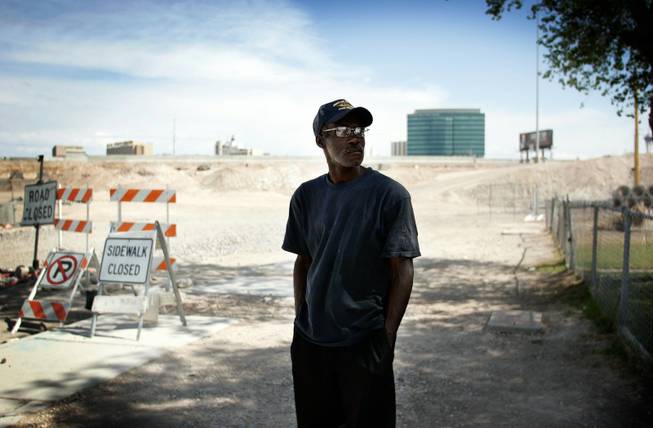
Saul Willis stands on the portion of F Street near his home at McWilliams Avenue that was closed in September to make way for the Interstate 15 widening project.
Sunday, June 28, 2009 | 2 a.m.
Sun Archives
- F Street Fiasco (6-10-2009)
- Protesters march against closure of F Street (4-18-2009)
- Roadwork works up West Las Vegans (12-1-2008)
F Street Lawsuit/Indymac Lawsuit
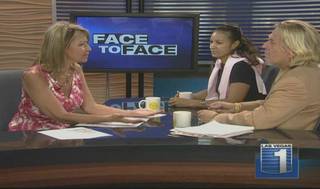
Viewing video requires the latest version of Adobe's Flash Player
Las Vegans know how the controversy over the closure of F Street was resolved: The Legislature ordered the city and state to devise a plan to reopen the street and to pay for it.
More instructive for a city hoping to avoid similar gaffes in the future may be looking at how the decision to close the street in the first place caught residents off guard, opened old wounds and will end up costing taxpayers $40 million to $70 million.
These are millions the recession-racked governments say they don’t have and could have saved had more residents been aware of the plan. The proposal might have been stopped then.
Instead, advocates had to march, hire a lawyer and lobby lawmakers to force the reopening of F Street, after the fact.
“I feel that all the hard work and all the letters from the community were truly being heard,” said Trish Geran, a writer and activist behind the group Stop the Closure of F Street.
The group said last year’s closure — near where the road passed beneath Interstate 15 — shut off residents of historically black West Las Vegas from the burgeoning, $6 billion Symphony Park, perpetuating a decades-long pattern of cutting off the neighborhood from the rest of the city.
The Nevada Transportation Department has said its initial plan didn’t call for the closure of F Street, but city officials requested it so the street wouldn’t be inundated with potentially dangerous “cut-through” traffic.
Others, however, have alleged ulterior motives, citing the city’s historical mistreatment of West Las Vegas and the street’s link to the city’s most prized development.
Regardless of the motive, the closure and successful effort sponsored by state Senate Majority Leader Steven Horsford to reopen the street leave the city and state on the hook for a lot of money.
The city’s Redevelopment Agency will have to pay $2.5 million to design a construction plan. The city will pay another $20 million, raised from property taxes beginning in 2011.
The Transportation Department will be responsible for the rest, currently estimated to be from $20 million to $50 million.
“I’d rather take the $20 million ... and build a wonderful new community center, a new library, a new art museum, put it into the old West Side school there,” Mayor Oscar Goodman said. “But Sen. Horsford apparently wants to hole-poke through a $70 million hole.”
•••
Among the lingering questions are how the decision to close F Street was made in the first place, and how the community was told.
Different parties have differing recollections — but a paper trail dates to 2004.
The Transportation Department began the federal environmental impact process necessary for the I-15 widening that autumn, according to department Director Susan Martinovich. At that time, NDOT’s plan was to keep F Street open, she said.
But in mid-2005, Martinovich said, city officials told the department it needed to close F Street, saying they were prepared to change the city’s master plan of streets and highways to include the closure.
At a Las Vegas Planning Commission meeting on Dec. 15, 2005, the commission approved the closure and several other street modifications to accommodate the $240 million widening of I-15. But according to the minutes of that meeting, there is no direct mention that F Street would close.
The following month, the Las Vegas City Council formalized its changes to the master plan. Again, according to minutes, there was no mention of F Street’s closure.
The first time the council gave some form of public notice was on Aug. 2, 2006. During that council meeting, a Transportation Department official gave a nine-page PowerPoint presentation on the I-15 project.
The seventh slide, an overhead view of the area, points to the corner of F Street and McWilliams Avenue with a block of text that reads “F St Ends.” The slide also shows the planned connector between D Street and F Street south of I-15 that will allow traffic coming north on F Street to be diverted. (South of Bonanza Road the street was renamed City Parkway.)
While the project was being developed, Lawrence Weekly — the councilman in Ward 5, where that portion of F Street is located — said he had no idea the street was to be closed. He acknowledged the closure may have been noted on a PowerPoint slide and that he may have missed it. But he’s positive there was never any discussion.
“I would have brought this issue up at community meetings, to be sure,” Weekly said. “I remember when West Las Vegas had to protest to keep F Street open in the first place. So why wouldn’t I want to keep it open if I had known about it this time?”
Weekly was referring to 1968, when the city tried to wall off West Las Vegas from much of the rest of Las Vegas by closing D, F and H streets. More than 300 neighborhood residents marched on City Hall, and officials reversed course.
Now a Clark County commissioner, Weekly said he was “thrown for a loop” when he first was told the news about F Street by his interim council successor, Brenda Williams.
Ward 5’s current councilman, Ricki Barlow, could not be reached for comment for this story. Barlow held a community meeting about the topic soon after the issue exploded in September. More recently, he testified in favor of Horsford’s legislation to open F Street.
From 2004 to 2007, the Transportation Department held three public meetings to discuss the I-15 project. It is unclear whether F Street’s closure was discussed. It wasn’t mentioned on the notices for the first two meetings, in November 2004 and July 2005. The notice for the third meeting, in June 2006, mentioned “a new connection road linking D Street and F Street between I-15 and Bonanza Road” — but nothing directly on F Street’s closure.
A department mailer sent in February 2006 to nearby residents includes the same PowerPoint graphic showing the F Street closure. It also talks about the connector between D and F streets.
“The connector road, and future City of Las Vegas improvements to F Street to the south, will also improve access for increased traffic generated by the World Market Center, Las Vegas Premium Outlet expansion, and the 61-acre ‘Union Park’ Master Plan,” the mailer said.
The mailer, however, was sent only to homes within 400 feet of the site — a total of four residents, Geran said.
The result, she said, was that virtually no one in the community knew about the closure until it happened. “There are people who have knowledge of every single thing in the community that’s going on — and even they didn’t know about it,” Geran said.
One man who might have expected to receive notice, Saul Willis, who lives on the corner of F and McWilliams, said he learned about the closure the day the earth-moving vehicles showed up.
“It took me by total surprise,” said Willis, who has lived in his home for more than a dozen years and runs a small auto repair shop in his garage. “They should have knocked on my door and warned me. It’s had a total effect on my whole life, not just my business.”
Martinovich said not only is her agency blameless, but it’s unfairly stuck with most of the cost of the fix, a fix that will hurt the department’s ability to complete other projects.
“The money is finite,” she said. “Without new money, something isn’t getting done.”
Still, she said in retrospect the department wouldn’t handle it any differently.
“We followed all the processes that we needed to follow,” Martinovich said. “The project, the whole I-15 project, there were public hearings and for the modifying of the (city’s) master plan. Both the city and the state acted in good faith.”
•••
It may take years for F Street to reopen. The I-15 widening project must first be completed, as well as environmental and design studies and a Regional Transportation Commission planning process. It could be as long as a decade before F Street — most likely in the form of a tunnel under I-15 — is reopened.
The reason for the high costs, according to department officials, is that the widening of I-15 lowered the freeway. A reopened F Street would therefore have to be lowered and four structures — two I-15 bridges and two interchange ramps — modified to preserve the required 16-foot-6-inch distance between roadways.
Matthew Callister, the attorney for the West Las Vegas residents who want the street reopened, said he’s unlikely to drop the lawsuit, even though the underlying issue has been resolved. The suit claims the closure of F Street violated Title VI of the federal Civil Rights Act, which prohibits race-based discrimination in federally funded programs.
Callister said a big part his job now will be to monitor how the new law is implemented, “to make sure the money goes where it’s supposed to go.”
Callister, a former Las Vegas councilman, said he believes the government’s poor record of notifying citizens of F Street’s closure wasn’t accidental. “It has to have been an intentional act. They wanted to wall off the poorest minority area and keep it walled off,” he said.
Callister isn’t the only one who — citing the historical treatment of West Las Vegas, and how F Street directly links to the gleaming vision of Symphony Park — believes the city’s push to close the street didn’t happened for the innocent reasons offered.
Yet no one contacted by the Sun could show proof that there were hidden motives at play.
“It is speculation at this point,” Horsford said. “All I can do is take these leaders at their word.”
For his part, Goodman said he understands the symbolic nature of the outcry over F Street. But don’t blame the city, he said.
“All I know that is that I’ve gone to the West Side my entire adult life,” the mayor said. “I’m one of the few white lawyers who used to represent the young African-Americans who had criminal problems over there. I would go there, and I always took Las Vegas Boulevard, I took Martin Luther King, I took Owens, I took Washington — I never took F Street in my life.
“I understand symbolism, and I sympathize with symbolism, because if I felt that I was being picked upon because of color, race or belief, I would be livid. But that certainly was not our intention here. I wish all these things had been brought up initially so we could address them.”
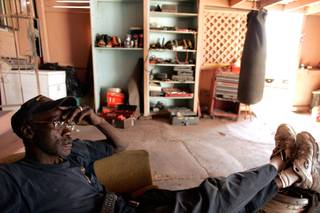
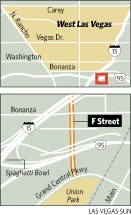
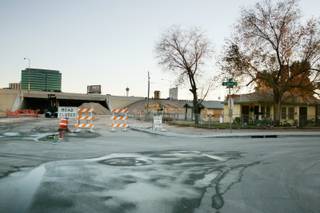
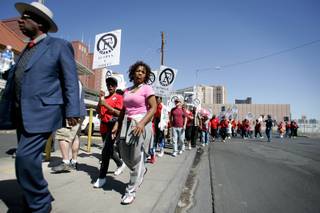

Join the Discussion:
Check this out for a full explanation of our conversion to the LiveFyre commenting system and instructions on how to sign up for an account.
Full comments policy